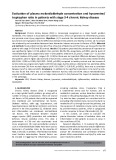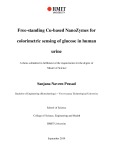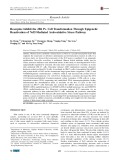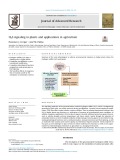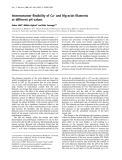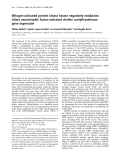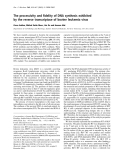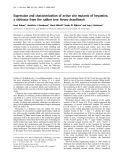Cotton GhMPK2 is involved in multiple signaling pathways and mediates defense responses to pathogen infection and oxidative stress Liang Zhang1, Dongmei Xi2, Lu Luo1, Fei Meng1, Yuzhen Li1, Chang-ai Wu1 and Xingqi Guo1
1 State Key Laboratory of Crop Biology, Shandong Key Laboratory of Crop Biology, Shandong Agricultural University, Taian, Shandong, China 2 Experimental Center, Linyi University, Linyi, Shandong, China
Keywords cotton; disease resistance; GhMPK2; oxidative stress; signaling pathways
Correspondence X. Guo, State Key Laboratory of Crop Biology, College of Life Sciences, Shandong Agricultural University, Taian, Shandong, 271018, China Fax: +86 538 8226399 Tel: +86 538 8245679 E-mail: xqguo@sdau.edu.cn
(Received 10 December 2010, revised 15 February 2011, accepted 18 February 2011)
doi:10.1111/j.1742-4658.2011.08056.x
Mitogen-activated protein kinase (MAPK) cascades play important roles in mediating pathogen responses and reactive oxygen species signaling. In plants, MAPKs are classified into four major groups (A–D). Previous stud- ies have mainly focused on groups A and B, but little is known about group C. In this study, we functionally characterized a stress-responsive group C MAPK gene (GhMPK2) from cotton. Northern blot analysis indi- cated that GhMPK2 was induced not only by signaling molecules, such as ethylene and methyl jasmonate, but also by methyl viologen-mediated oxi- dative stress. Transgenic tobacco (Nicotiana tabacum) plants that overex- press GhMPK2 displayed enhanced resistance to fungal and viral pathogens, and the expression of the pathogenesis-related (PR) genes, including PR1, PR2, PR4, and PR5, was significantly increased. Interest- ingly, the transcription of 1-aminocyclopropane-1-carboxylic acid synthase (ACS) and 1-aminocyclopropane-1-carboxylic acid oxidase (ACO) was sig- nificantly upregulated in transgenic plants, suggesting that GhMPK2 posi- tively regulates ethylene synthesis. Moreover, overexpression of GhMPK2 elevated the expression of several antioxidant enzymes, conferring on trans- genic plants enhanced reactive oxygen species scavenging capability and oxidative stress tolerance. These results increased our understanding of the role of the group C GhMPK2 gene in multiple defense-signaling pathways, including those that are involved in responses to pathogen infection and oxidative stress.
Introduction
Abbreviations ABA, abscisic acid; ACC, 1-aminocyclopropane-1-carboxylic acid; ACO, 1-aminocyclopropane-1-carboxylic acid oxidase; ACS, 1-aminocyclopropane-1-carboxylic acid synthase; APX, ascorbate peroxidase; CAT, catalase; CMV, cucumber mosaic virus; CP, coat protein; DAB, 3,3¢-diaminobenzidine; EREBP, ethylene-responsive element-binding protein; ET, ethylene; GST, glutathione-S-transferase; JA, jasmonic acid; MAPK, mitogen-activated protein kinase; MeJa, methyl jasmonate; MV, methyl viologen; PR, pathogenesis-related; RbohD, respiratory burst oxidase homolog; ROS, reactive oxygen species; SA, salicylic acid; SOD, superoxide dismutase; TMV, tobacco mosaic virus.
FEBS Journal 278 (2011) 1367–1378 ª 2011 The Authors Journal compilation ª 2011 FEBS
1367
Plants are constantly exposed to a variety of biotic and abiotic stresses. To survive these challenges, plants have developed elaborate mechanisms to perceive external signals and to manifest adaptive responses with appropriate physiological and morphological changes [1]. At the molecular level, the perception of extracellular stimuli and the subsequent activation of the defense responses require a complex interplay of signaling cascades, in which reversible protein phos- phorylation plays a central role [2]. The mitogen-acti- vated protein kinase (MAPK) cascade is a highly conserved pathway involved in the phosphorylation of
L. Zhang et al.
Cotton GhMPK2 is involved in multiple signaling pathways
a wide range of substrates, and it has been suggested to be the integrative point of multiple pathways [3].
glutathione-S-transferases such as
activates AtMPK12 in Arabidopsis and MMK3 in alfalfa [19,20], whereas constitutive expression of Ara- bidopsis MKK4 or MKK5 results in the generation of H2O2 [21]. One of the mechanisms that contributes to ROS-induced pathogen tolerance is the activation of a large number of enzymatic and nonenzymatic antioxi- dants, (GSTs), ascorbate peroxidases (APXs), superoxide dismutases (SODs), and catalases (CATs) [14]. However, evidence for the effect of MAPKs on antioxidant gene expres- sion is lacking. effectors, which reprograms
The MAPK cascade consists of three interlinked protein kinases: a MAPKKK kinase, a MAPKK, and a MAPK [4]. Signals from extracellular stimuli are transmitted into the cell and are sensed by downstream targets via the sequential phosphorylation of a MAP- KKK, a MAPKK, and a MAPK [5]. The phosphory- lation and activation of an MAPK can lead to changes in its subcellular localization and its interaction with transcriptional gene expression [6]. Plant genome sequencing projects have revealed the existence of 20 MAPKs in Arabidopsis [4], 17 in rice [7], and 21 in poplar [8]. The MAPKs can be classified into four major groups (A, B, C, and D) on the basis of their sequence homology and the con- served phosphorylation motifs [4].
Previous studies have mainly focused on group A and B MAPKs; information about group C MAPKs is relatively limited and has emerged only recently. It has been shown that Arabidopsis thaliana AtMPK1 and AtMPK2 are induced by wounding, jasmonic acid (JA), abscisic acid (ABA), and H2O2 [22–24]. The expression patterns of pea PsMPK2 in Arabidopsis revealed that its kinase activity increases in response to mechanical including injury and other stress signals, ABA, JA, and H2O2 [23]. Recently, it was shown that maize ZmMPK7 was induced by ABA and H2O2, and that H2O2 may be required for ZmMPK7-mediated ABA signaling [24]. Increasing evidence has revealed that group C MAPKs are involved in various signaling processes and have unique biological functions. SAMK in SIMK and alfalfa,
In plants, several lines of evidence have revealed that the MAPK cascades can both positively and negatively mediate pathogen signal transduction [9]. In tobacco, salicylic acid (SA)-induced protein kinase and wound- induced protein kinase, two MAPKs in group A, were activated by inoculation with the tobacco mosaic virus (TMV) [10]. Their orthologs in other plant species, including MPK3 and MPK6 in Arabidopsis (group A and MAPKs), LeMPK1 ⁄ 2 (Lycopersicon esculentum SA-induced pro- tein kinase) and LeMPK3 (L. esculentum wound- induced protein kinase) in tomato, are all involved in defense-related signal transduction [11]. In contrast, the Arabidopsis group B transposon inactivation of MPK4 gene conferred enhanced disease resistance and constitutive activation of defense responses, indicating that MPK4 functions as a negative regulator of systemic acquired resistance [12]. In rice, group A OsMAPK5 negatively modulates pathogenesis-related (PR) gene expression and broad-spectrum disease resis- tance [13].
results
FEBS Journal 278 (2011) 1367–1378 ª 2011 The Authors Journal compilation ª 2011 FEBS
1368
Cotton (Gossypium hirsutum) is one of the oldest and most important fiber and oil crops. Its growth and yield are severely inhibited under various biotic and abiotic stress conditions. To date, few MAPKs have been identified in cotton, and their function has not been well documented. In our previous work, GhMAPK was the first group C MAPK isolated from cotton, and it was shown to be activated by wounding, cold, salt, SA, H2O2, and pathogens [25]. However, its in vivo function has not been elucidated. In this study, a more detailed analysis of GhMAPK was carried out in tobacco. It should be noted that GhMAPK has been renamed as GhMPK2 on the basis of the nomenclature for plant MAPKs showed that [4]. Our GhMPK2 was strongly induced by ethylene (ET), JA, and methyl viologen (MV). The ectopic expression of GhMPK2 in transgenic tobacco plants led to enhanced resistance to fungi and viruses. This resistance was most probably attributable to elevated constitutive lev- els of basal resistance, because uninfected plants showed upregulated expression of PR and ET biosyn- thesis genes. Moreover, plants that overexpressed GhMPK2 showed an increased ability to scavenge ROS and to tolerate oxidative stress. Thus, this study suggests a role for GhMPK2 in the defense signaling pathways in response to both pathogen infection and oxidative stress. Abiotic and biotic stresses are typically associated with the rapid production of reactive oxygen species (ROS), including hydrogen peroxide (H2O2), superox- ide anion (O(cid:2) 2 ), and hydroxyl radicals [14]. ROS are known to play dual roles, depending on their levels; moderate accumulation of ROS plays a central role in the regulation of biological processes, such as hormone signaling, biotic and abiotic stress responses, and development [15,16], whereas high concentrations of ROS can result in oxidative stress and cause irrevers- ible damage and hypersensitive response-like cell death [14,17]. MAPKs are key players in ROS signaling. Sev- eral studies have shown that MAPK signaling path- ways are not only induced by ROS but can also regulate ROS production [15,18]. For example, H2O2
L. Zhang et al.
Cotton GhMPK2 is involved in multiple signaling pathways
Results
Fig. 1. Northern blot analysis of GhMPK2 expression induced by stresses and hormone signals. One-week-old cotton seedlings were treated with 10 lM MV, ET released from 5 mM ethephon, 100 lM MeJA, and 100 lM AgNO3 alone or 100 lM AgNO3 with 5 mM ethephon. a-32P-labeled GhMPK2 cDNA was used as the probe. Ethidium bromide-stained rRNA was included as a loading control. The gene expression level at 2 h after treatment with dis- tilled water served as the control (C).
Expression of GhMPK2 was upregulated by oxidative stress and phytohormones
Fig. 2. GhMPK2 expression analysis in wid-type and T1 transgenic tobacco plants. Three representative lines (OE1, OE2, and OE3) grown under normal conditions were selected for northern blot analysis and in-gel kinase activity assay. Ethidium bromide-stained rRNA and Coomassie Brilliant Blue (CBB)-stained blots were included as the loading controls. WT, wild-type.
To study the effect of oxidative stress and signaling molecules on the expression of GhMPK2, total RNA was extracted from 7-day-old cotton seedlings treated with 10 lm MV, ET released from 5 mm ethephon or 100 lm methyl jasmonate (MeJA) for northern blot analysis. As shown in Fig. 1, GhMPK2 expression was strongly induced at 2 h and then reduced at 4 h in the presence of MV or MeJA. After ethephon treatment, GhMPK2 transcripts showed a gradual increase from 2 h to 4 h. Because Ag+ acts as an ET action repres- sor by blocking ET signaling [26], 100 lm AgNO3 100 lm AgNO3 with 5 mm ethephon alone or (ET + Ag+) was applied to the cotton seedlings. The results showed that the expression of GhMPK2 was significantly increased by AgNO3 at 2 h, and that this was followed by a slight decrease at 4 h. However, when treated with ET + Ag+, GhMPK2 mRNA rap- idly accumulated at 2 h and was almost undetectable at 4 h. Comparison of the expression patterns after treatment with ET + Ag+ and with ET alone revealed that the induction of GhMPK2 by ethephon was partly blocked by the addition of Ag+. These results suggest that GhMPK2 might be involved in the oxidative stress response and in the JA ⁄ ET signaling pathway.
Overexpression of GhMPK2 in tobacco plants improved viral resistance
appeared the wild-type
To investigate the functional roles of GhMPK2 in plant defense, we generated transgenic tobacco plants that constitutively expressed GhMPK2 under the con- trol of the cauliflower mosaic virus 35S promoter. A total of 19 independent transgenic lines were obtained by kanamycin resistance selection, and were confirmed by genomic PCR detection (data not shown). Three representative lines (OE1, OE2, and OE3) of T3 prog- eny were randomly selected for further investigation. Northern blot analysis showed that the transgenic lines accumulated much higher levels of GhMPK2 tran- scripts than the wild-type. As expected, the myelin basic protein kinase activity of GhMPK2 was signifi- cantly increased in the transgenic lines grown under normal conditions (Fig. 2).
indicate results
FEBS Journal 278 (2011) 1367–1378 ª 2011 The Authors Journal compilation ª 2011 FEBS
1369
To analyze the viral resistance responses in the transgenic tobacco plants, 8-week-old plants were inoc- ulated with TMV and cucumber mosaic virus (CMV). To ensure consistent comparison of the symptoms observed on the systemically infected leaves between the wild-type and OE plants, the sixth or seventh true leaves were inoculated with TMV or CMV, and the 10th true leaves were used for the determination of virus accumulation and photography. Fourteen days after the inoculation, leaf curling, stunting and other abnormalities plants in (Fig. 3A). However, only slight disease symptoms were observed on the transgenic plants, and no symptoms were observed on the mock-inoculated plants. The root fresh weight of the transgenic plants was much higher than that of the wild-type plants (Fig. 3B). In addition, the expression of the viral coat protein (CP) gene was detected by semiquantitative RT-PCR, and the results showed that virus accumulation in the transgenic lines was much lower than in the wild-type plants (Fig. 3C). Quantitative ELISA analysis revealed that the accumu- lation of TMV or CMV particles in the wild-type plants was approximately 1.5-fold higher than the average value for the transgenic lines at 21 days post- that inoculation (Fig. 3D). These overexpression of GhMPK2 confers enhanced viral resistance in transgenic plants.
L. Zhang et al.
Cotton GhMPK2 is involved in multiple signaling pathways
A
B
C
D
Fig. 3. Enhanced viral resistance against TMV and CMV in transgenic tobacco plants overexpressing GhMPK2. (A) Leaf and root symptoms of tobacco plants infected with TMV and CMV at 14 days postinoculation (dpi). Mock: mock inoculation. (B) The root weight of the transgenic plants and the con- trol plants at 14 days postinoculation. Differ- ent letters above the columns indicate significant differences (P < 0.01) according to Duncan’s multiple range test. (C) Expres- sion analysis of virus CP genes by semi- quantitative RT-PCR. (D) Virus accumulation as determined by ELISA. Data in (B) and (D) are the mean ± standard error from three independent experiments.
Overexpression of GhMPK2 conferred enhanced resistance to fungal pathogens
levels of several disease-responsive genes, including PR1a, PR2 (b-1,3-glucanase), PR4, PR5 (osmotin), SAR8.2l, and CBP20, were determined by northern blot analysis. As shown in Fig. 5, the transcripts of these genes were significantly upregulated in the transgenic plants, with the exception of that of CBP20, whose accumulation was not obviously altered. Notably, PR1a and PR5 are the marker genes for SA signaling, and PR4 is the mar- ker gene for MeJA signaling. Thus, we propose that the GhMPK2-dependent activation of the PR genes plays a key role in enhanced disease resistance in transgenic plants, which might be related to SA-dependent and MeJA-dependent signaling pathways.
To determine the effect of GhMPK2 overexpression on fungal resistance, tobacco plants were challenged with the Fusarium oxysporum and Phytophthora parasitica patho- gens. Ten days postinoculation, wild-type leaves exhibited wilting and yellowing with necrotic lesions, and the stems displayed significant black shank. However, the trans- genic plants showed less severe or no disease symptoms (Fig. 4A,B). Typically, the pathogen mainly invades plants at the root tips, so close attention was paid to the growth phenotype of the roots. The roots of the trans- genic plants developed much better than those of the wild-type plants, with reduced growth inhibition and only partial secondary root browning. These results indicate that overexpression of GhMPK2 greatly enhances resis- tance to fungal pathogens in transgenic tobacco plants.
Overexpression of GhMPK2 activated disease response and ET biosynthesis genes in transgenic tobacco plants
FEBS Journal 278 (2011) 1367–1378 ª 2011 The Authors Journal compilation ª 2011 FEBS
1370
To elucidate the possible mechanisms of enhanced path- the expression ogen resistance in transgenic plants, In addition, we examined the expression of two key enzymes that are involved in ET biosynthesis, 1-amino- cyclopropane-1-carboxylic acid (ACC) synthase (ACS) and ACC oxidase (ACO), which catalyze the conver- sion of S-adenosyl-l-methione into ACC, and the oxi- dative cleavage of ACC to form ET, respectively [27]. As shown in Fig. 5, the transcriptional levels of ACS and ACO were significantly increased in transgenic plants without any stress treatment. The data indicate that GhMPK2 positively regulates ET synthesis in plants, suggesting a possible role for GhMPK2 in the ET signaling pathway.
L. Zhang et al.
Cotton GhMPK2 is involved in multiple signaling pathways
A
A
B
Fig. 5. Expression of the defense-related genes and ET biosynthe- sis genes in transgenic and wild-type plants. (A) The mRNA levels of defense-related genes and ET biosynthesis genes in transgenic and wild-type tobacco plants without any stress, analyzed by north- ern blot. Ethidium bromide-stained rRNA was included as a loading control. (B) The relative expression levels of the defense-related genes and ET biosynthesis genes in transgenic and wild-type tobacco plants. Transcriptional levels of these genes in transgenic tobacco are indicated relative to the level of wild-type tobacco, taken as 1, referring to the transcripts of CBP20 in the same sam- ples. WT, wild-type.
B
Fig. 4. Enhanced fungal resistance against pathogenic F. oxyspo- (A) rum and P. parasitica in GhMPK2 transgenic tobacco plants. Symptoms of the leaves, stems and roots of the tobacco plants inoculated with F. oxysporum at 10 days postinoculation. (B) Symp- toms of the leaves and stems of tobacco plants inoculated with P. parasitica at 10 days postinoculation. WT, wild-type.
GhMPK2 regulated the accumulation of ROS and H2O2. The accumulation of H2O2 and O(cid:2) 2 , which are the major ROS, was determined by 3,3¢-diam- inobenzidine (DAB) and Nitro Blue tetrazolium (NBT) staining, respectively. Under normal growth conditions, no obvious H2O2 was detected in either wild-type or transgenic plants. After TMV or CMV infection for 10 days, DAB staining of the third upper systemic leaves showed significantly reduced H2O2 production in transgenic plants as compared with wild-type plants (Fig. 6A). After treatment with NaCl, poly(ethylene gly- col), and H2O2, the accumulation of H2O2 was remark- ably lower in the transgenic lines than in the wild-type plants at 4 h (Fig. 6B). Similarly, NBT staining showed less O(cid:2) 2 accumulation in the leaves of the transgenic lines (Fig. 6B). The transgenic plants produced a lower amount of ROS, suggesting that overexpression of GhMPK2 either inhibited ROS production or effectively scavenged excess ROS.
GhMPK2-overexpressing plants displayed increased tolerance to oxidative stress
tobacco
FEBS Journal 278 (2011) 1367–1378 ª 2011 The Authors Journal compilation ª 2011 FEBS
1371
Because GhMPK2-overexpressing plants showed reduced ROS accumulation in response to bio- tic and abiotic stresses (Fig. 6), the possible protective Plants respond to pathogen attack by activating various defense responses. The production of ROS often follows pathogen invasion, and plays a critical role in defense responses [28]. To examine whether the enhanced dis- ease resistance of the transgenic plants is associated with ROS accumulation, tobacco plants were inoculated with viruses or treated with NaCl, poly(ethylene glycol),
L. Zhang et al.
Cotton GhMPK2 is involved in multiple signaling pathways
A
enhanced tolerance
B
Oxidative stress tolerance in transgenic plants was further studied by testing the tolerance of leaf disks from 8-week-old plants to exogenous MV. As shown in Fig. 7E, the discs incubated in water without MV showed no abnormalities. After incubation in different concentrations of MV for 72 h, symptoms of bleaching or chlorosis appeared in the leaf disks from both wild- type and transgenic plants. However, MV treatment led to more severe damage in the wild-type plants. This result was further confirmed by measuring the chlorophyll content in the leaf disks after MV treat- ment (Fig. 7F). These results indicate that overexpres- sion of GhMPK2 confers to oxidative stress during the vegetative stage.
Fig. 6. Analysis of ROS accumulation in wild-type and transgenic plants in response to abiotic and abiotic stresses. (A) Virus infec- tion-induced H2O2 accumulation detected by DAB staining. (B) Abi- otic stress-induced H2O2 and O(cid:2) 2 accumulation detected by DAB staining and NBT staining, respectively. WT, wild-type.
Expression of antioxidant enzymes was upregulated in transgenic tobacco plants
the total activities of
Plants have evolved antioxidant defense systems to dis- pose of excess ROS and to maintain cellular ROS homeostasis [17]. To investigate the possible underlying mechanisms of the enhanced oxidative stress tolerance in transgenic plants, the expression of genes that encode ROS-scavenging enzymes, such as MnSOD, CAT1, APX, and GST, as well as the ROS producer, respira- tory burst oxidase homolog (RbohD), was determined by northern blot analysis. The mRNA levels of CAT1 and APX, and particularly of MnSOD and GST, were greatly upregulated in the transgenic plants, whereas RbohD transcripts showed no obvious difference between the transgenic and wild-type plants (Fig. 8A,B). Moreover, after treatment with NaCl or poly(ethylene glycol) 6000, the antioxidant enzymes SOD, CAT and APX in the transgenic plants were significantly higher than in the wild-type (Fig. 8C). These results indicate that the enhanced oxidative stress tolerance in GhMPK2-overexpressing plants is conferred by upregulation of the expression of multiple antioxi- that GhMPK2 may be dant enzymes, and suggest involved in the regulation of ROS network pathways.
Discussion
the characterization of the
FEBS Journal 278 (2011) 1367–1378 ª 2011 The Authors Journal compilation ª 2011 FEBS
1372
transgenic during plants stress in role of GhMPK2 against oxidative stress was evaluated by testing the tolerance of the plants to MV. In 1 ⁄ 2 Murashige–Skoog medium without addition of MV, no difference was observed between the wild-type and transgenic lines. However, a large variation in the ger- mination rate occurred in the presence of MV (Fig. 7A,B). Four days after sowing, 5 lm MV severely inhibited the germination of the wild-type seeds, which had a germination rate of only 14%, whereas the transgenic seeds displayed a high tolerance to MV, achieving a 32% germination rate. At a higher dose (10 lm MV), the remarkable protection against MV was still observed in the GhMPK2-overexpressing lines, with an approximately 20% higher germination rate than in the wild-type on day 4, a 16% higher rate on day 6, and a 13% higher rate on day 8. Measurements of the root length and fresh weight revealed a similar pattern (Fig. 7C,D). These data suggest that the over- expression of GhMPK2 may improve tolerance to oxi- dative seed germination. The role and significance of group C MAPKs in response to biotic and abiotic stresses have only recently begun to emerge [22–24]. In the present study, cotton we describe GhMPK2 gene, which belongs to the group C MAPK family. Our results suggest that GhMPK2 plays impor- tant roles in disease resistance responses and oxidative stress tolerance by triggering the expression of defense- related genes and antioxidant genes, respectively. The findings not only extend our knowledge of the biologi-
L. Zhang et al.
Cotton GhMPK2 is involved in multiple signaling pathways
A
B
D
C
E
F
Fig. 7. Overexpression of GhMPK2 confers increased tolerance to oxidative stress. (A) Seed germination in the presence of the indicated MV concentrations. (B) Germination rates of the wild-type and OE lines shown in (A). Different letters above the columns indicate significant differences (P < 0.05) according to Duncan’s multiple range test. (C, D) The phenotypes of the plants treated with MV are shown in (C), and their corresponding relative root lengths and fresh weights are shown in (D). Different letters above the columns indicate significant differ- ences (P < 0.05) according to Duncan’s multiple range test. (E) Leaf disks from wild-type and transgenic plants were infiltrated with different concentrations of MV (0, 5 and 10 lM). (F) Relative chlorophyll contents in the leaf disks after MV treatments. The data in (B), (D) and (F) are the mean ± standard error from three independent experiments. WT, wild-type.
FEBS Journal 278 (2011) 1367–1378 ª 2011 The Authors Journal compilation ª 2011 FEBS
1373
cal function of group C MAPKs, but also provide new insights for further exploration of the significance of GhMPK2 in the regulation of plant defense responses. It has been previously established that the signaling molecules SA, ET and JA play important roles in the regulation of the complex defense mechanisms [29]. SA is an essential signaling molecule that induces systemic acquired ressitance and is implicated in resistance to biotrophic pathogens [29–31]. ET and JA are typically associated with the defense responses to necrotrophic pathogens and herbivorous insects [29,32]. In Arabid- opsis, AtMPK4 responds to the balance between SA
L. Zhang et al.
Cotton GhMPK2 is involved in multiple signaling pathways
B
A
C
Fig. 8. Overexpression of GhMPK2 acti- vates antioxidant enzymes in transgenic tobacco plants. (A) The mRNA levels of oxi- dative stress-related genes in the transgenic and wild-type tobacco plants analyzed by northern blot analysis. The ethidium bro- mide-stained rRNA was included as a load- ing control. (B) The relative expression levels of the oxidative stress-related genes in the transgenic and wild-type tobacco plants. Transcriptional levels of these genes in transgenic tobacco are indicated relative to the level of wild-type tobacco, taken as 1, referring to the transcripts of CAT1 in the same samples. (C) The total activities of the antioxidant enzymes SOD, CAT and APX in the tobacco plants when treated with NaCl or poly(ethylene glycol) 6000. Data are the means ± standard errors of three indepen- dent experiments. Different letters above the columns indicate significant differences (P < 0.05) according to Duncan’s multiple range test. FW, fresh weight; WT, wild-type.
the and SA-mediated
analysis of
FEBS Journal 278 (2011) 1367–1378 ª 2011 The Authors Journal compilation ª 2011 FEBS
1374
and MeJA through the EDS1–PAD4 module, and regulates JA ⁄ ET-mediated defence responses [33]. Like AtMPK4, GhMPK2 might be involved in the crosstalk between the SA-mediated and JA ⁄ ET-mediated pathogen defense signaling path- ways. Generally, the gene expression pattern is an indi- cation of gene function. A remarkable increase in the expression of GhMPK2 was observed in the cotton seedlings treated with exogenous ET and JA (Fig. 1). Our previous report showed that the transcriptional levels of GhMPK2 could be greatly upregulated by SA treatment [25]. These results imply that GhMPK2 may play roles in both plant defense responses and in the regulation of certain components of multiple stress-sig- naling pathways. Consistent with this hypothesis, sequence analysis of the GhMPK2 promoter (GenBank accession no. HM150999), using the PLACE and PlantCARE databases, revealed the existence of an SA-responsive element, as-1, and an MeJA-responsive cis-acting regulatory element (CGTCA motif ⁄ TGACG motif) (data not shown). More direct evidence was ectopically obtained from functional expressed GhMPK2 in Nicotiana tabacum. As shown in Figs 3 and 4, the transgenic plants displayed enhanced resistance to both viruses and fungi. In addition, the expression of the marker genes from various pathways (PR1a and PR5 for SA signaling; PR4 for MeJA sig- naling) was greatly elevated (Fig. 5). Furthermore,
L. Zhang et al.
Cotton GhMPK2 is involved in multiple signaling pathways
GhMPK2 positively regulated ET synthesis in plants, as shown by the significant increase in expression of the ET biosynthesis genes ACS and ACO (Fig. 5). Thus, it is reasonable to speculate that GhMPK2 may inhibit the pathogens by influencing both the SA-medi- ated and the JA ⁄ ET-mediated defense responses.
[34]. lated as the substrate by a MAPK in rice, BWMK1 [39]. In addition, WRKYs can specifically recognize W-box elements that are conserved in the promoters of many PR genes (PR1, PR2, PR3, and PR5), and there- these defense genes fore induce the expression of [40,41]. In this study, the mRNA levels of these PR genes were all upregulated in the transgenic plants. Therefore, we speculate that EREBPs and WRKYs may play important roles downstream of GhMPK2 in pathogen defense signaling.
least two regulatory pathways
On the basis of these observations, we propose that there are at for GhMPK2, one of which responds to pathogens and the other of which is involved in oxidative stress responses. GhMPK2 may serve as a crosstalk point between biotic and abiotic stress responses. Further investigation is required for a more comprehensive understanding of the functional roles and mechanisms of action of GhMPK2 in plant defense. As we learn more about MAPKs and their regulation, the design of efficient strategies for crop improvement should become possible.
Experimental procedures
Cotton (G. hirsutum L. cv. lumian 22) seeds were surface-ster- ilized and germinated on 1 ⁄ 2 Murashige–Skoog medium. The seedlings were grown in a growth chamber under greenhouse conditions of 28 (cid:2)C with a 16 h light ⁄ 8 h dark cycle. For the MV, MeJA, and ET treatments, 7-day-old cotton seedlings were sprayed with 10 lm MV, 100 lm MeJA, and 5 mm ethe- phon (ET-releasing chemical), respectively. For the AgNO3 treatment, 100 lm AgNO3 alone or 100 lm AgNO3 in combi- nation with 5 mm ethephon was applied to the seedlings.
Plant materials, growth conditions, and treatments
(strain LBA4404)
for
Vector construction and genetic transformation
The GhMPK2 cDNA (GenBank accession no. DQ132852) was inserted into the binary vector pBI121 under the control of the cauliflower mosaic virus 35S promoter via BamHI and SacI sites. The recombinant plasmid was electroporated into Agrobacterium tumefaciens tobacco transformation with the leaf disk method, and the transfor- mants were screened for kanamycin (100 mgÆL)1) resistance. The transgenic T3 lines were used in the experiments.
In plants, ROS have been implicated in the damag- ing effects of various environmental stresses. How- ever, cells have evolved strategies to utilize ROS in In Arabidopsis, multiple biological pathways H2O2 activates the MKK3–MPK7 module, which induces target genes, such as PR1, and therefore acti- vates the defense responses [35]. As shown by Naka- gami et al. [36], Arabidopsis MPK4 is the downstream target of MEKK1, and MEKK1–MPK4 can maintain ROS homeostasis by regulating the expression of a group of redox-related genes. In the present study, our results suggest that GhMPK2 may play key roles in ROS homeostasis and that ROS-mediated injury may be effectively alleviated by the induction of GhMPK2. On the one hand, GhMPK2 was strongly induced in response to MV, which can cause continu- ous formation of O(cid:2) (Fig. 1), suggesting that ROS 2 participate in the activation of GhMPK2. On the other hand, GhMPK2 was demonstrated to regulate ROS production. As shown in Fig. 6, GhMPK2 trans- genic lines accumulated much lower amounts of ROS (mainly H2O2 and O(cid:2) in the presence of NaCl, 2 ) poly(ethylene glycol), and H2O2, which can trigger the excessive accumulation of ROS. Consistent with this finding, the transgenic plants developed signifi- cantly better than the wild-type plants during seed germination and the vegetable growth stage when treated with MV (Fig. 7). Further analysis revealed that the increase in oxidative stress tolerance was achieved through the constitutive upregulation of multiple antioxidant enzymes in the GhMPK2 trans- genic lines (Fig. 8). Therefore, the excessive accumula- tion of ROS may induce the expression of GhMPK2 and lead to the direct or indirect upregulation of antioxidant genes, which will result in the scavenging of excessive ROS and the maintenance of the ROS at moderate levels. This study provides direct evidence of a link between MAPK and antioxidant genes.
With an RNeasy Mini Kit (Qiagen, MD, USA), 20 lg of total RNA was extracted according to the manufacturer’s instructions, and was separated on a 1% agarose– formaldehyde gel. RNA was transferred onto Hybond-N+
Northern blot analyses
FEBS Journal 278 (2011) 1367–1378 ª 2011 The Authors Journal compilation ª 2011 FEBS
1375
It has been reported that plant MAPKs can phos- phorylate transcription factors, such as ET-responsive (EREBPs) and WRKYs, element-binding proteins which then triggers the expression of the PR genes [9,37]. EREBPs, which are implicated in the ET signal- ing pathway, can bind to the GCC box DNA motif (AGCCGCC) of the promoters of several PR genes, such as PR1a, PR2, PR4, and PR5, in tobacco [38]. OsEREBP1 has been demonstrated to be phosphory-
L. Zhang et al.
Cotton GhMPK2 is involved in multiple signaling pathways
membranes, and northern blot hybridizations were per- formed as previously described [25].
superoxide detection, evaluated by DAB staining. For tobacco leaves were treated with 200 mm NaCl, 15% poly(ethylene glycol) 6000 and 100 mm H2O2 for 4 h. The leaves were then collected and incubated in a Nitro Blue tetrazolium solution (0.1 mgÆmL)1) for 24 h at room tem- perature in the dark. After staining, the leaves were soaked in 95% ethanol overnight for chlorophyll removal. Seed- lings treated with water were used as controls.
The in-gel kinase activity assay was performed as previously described [21], with a slight modification. Extracts contain- ing 40 lg of protein were electrophoresed on 12% SDS ⁄ polyacrylamide gels with 0.25 mgÆmL)1 myelin basic protein embedded in the separating gel as a kinase substrate.
In-gel kinase activity assay
(NTU93244), APX (AF443182)
To study the possible effects of GhMPK2 overexpression in tobacco on defense-related genes, PR1a (X06361), PR2 (M60460), PR4 (X58546), osmotin (M29279), SAR8.2l (NTU96152), pathogen-inducible and wound-inducible anti- fungal protein gene (CBP20, S72452), ACS (AJ005002), ACO (AB012857), GST (D10524), MnSOD (AB093097), CAT1 and RbohD (AJ309006) were used for northern blot analyses.
Expression analysis of defense-related genes in transgenic tobacco plants Pathogen infection
spore
Tobacco seedlings were treated with 200 mm NaCl and 15% poly(ethylene glycol) 6000 for 4 days, and 0.5 g of leaves was then collected for SOD, CAT and APX measurements, which were performed as previously described [42].
For virus infection, 8-week-old tobacco plants were inocu- lated with 100 lL of TMV and CMV suspension inoculum (TMV and CMV in 50 mm phosphate buffer, pH 7.2) by rubbing the fully expanded true leaves with wet carborun- dum, and then immediately rinsing with deionized water. Tobacco plants inoculated with 100 lL of buffer were used as controls. For inoculation with pathogenic fungi, F. oxy- sporum f. sp. vasinfectum and P. parasitica var. nicotianae Tucker were cultured on potato dextrose agar (PDA) med- ium at 25(cid:2) C for 15 days, and the conidia were then sus- pended in 1% glucose. Eight-week-old wild-type and T3 OE tobacco plants were inoculated by irrigation with F. oxy- sporum and P. nicotianae Tucker suspensions (106 conidiaÆmL)1), respectively. The inoculated plants were maintained under greenhouse conditions.
Enzyme activity assays
Virus accumulation was determined at both the mRNA and protein levels by semiquantitative RT-PCR and ELISA, respectively. For the ELISA, TMV and CMV CPs the polyclonal antiserum. A were used to prepare 1 : 5000 (v ⁄ v) dilution of horseradish peroxidase-conjugated goat anti-(rat IgG) (Dingguo, Beijing, China) was used to detect the antibody against CP. Absorbance was measured at 492 nm with an ELISA plate reader. Upper noninoculat- ed true leaves were harvested at the specified times for mRNA and protein extraction.
ELISA detection of virus accumulation Analysis of the response of transgenic plants to oxidative stress
2 staining
To observe the growth performance of tobacco plants under oxidative stress conditions, the wild-type and trans- genic seeds were surface-sterilized and germinated on 1 ⁄ 2 Murashige–Skoog medium supplemented with different concentrations of MV (0, 5 and 10 lm). Leaf disks 1.3 cm in diameter were detached from healthy and fully expanded tobacco leaves of wild-type and transgenic plants at the same age. The disks were floated in solutions of various concentrations of MV (0, 5 and 10 lm) for 72 h, and then immersed in 80% acetone for 48 h to extract the chloro- phyll; the disks were then subjected to spectrophotometric measurement of chlorophylls a and b. The experiment was repeated at least twice, with five leaf disks each, for each of the transgenic lines.
Analysis of ROS scavenging on the basis of H2O2 and O2
Acknowledgements
to remove the chlorophyll. In addition,
For H2O2 staining, 3-week-old tobacco seedlings were trea- ted with 200 mm NaCl, 15% poly(ethylene glycol) 6000 and 100 mm H2O2 for 4 h by smearing the leaves with a cotton bud. The leaves were then collected and incubated in a DAB solution (1 mgÆmL)1, pH 3.8) for 12 h at 25 (cid:2)C in the dark. After staining, the leaves were soaked in 95% ethanol the overnight accumulation of H2O2 in 8-week-old tobacco plants that had been inoculated with TMV and CMV for 10 days was
FEBS Journal 278 (2011) 1367–1378 ª 2011 The Authors Journal compilation ª 2011 FEBS
1376
This work was financially supported by the Genetically Modified Organisms Breeding Major Projects of China (2009ZX08009-092B) and the National Natural Science Foundation of China (Grant no. 30970225).
L. Zhang et al.
Cotton GhMPK2 is involved in multiple signaling pathways
15 Pitzschke A & Hirt H (2009) Disentangling the com-
References
plexity of mitogen-activated protein kinases and reactive oxygen species signaling. Plant Physiol 149, 606–615.
1 Bohnert HJ, Nelson DE & Jensen RG (1995) Adapta-
16 Xue T, Li X, Zhu W, Wu C, Yang G & Zheng C
tions to environmental stresses. Plant Cell 7, 1099–1111.
2 Colcombet J & Hirt H (2008) Arabidopsis MAPKs: a complex signalling network involved in multiple biological processes. Biochem J 413, 217–226.
(2009) Cotton metallothionein GhMT3a, a reactive oxy- gen species scavenger, increased tolerance against abi- otic stress in transgenic tobacco and yeast. J Exp Bot 60, 339–349.
17 Mittler R (2002) Oxidative stress, antioxidants and
stress tolerance. Trends Plant Sci 7, 405–410.
3 Jonak C, Okresz L, Bogre L & Hirt H (2002) Complex- ity, cross talk and integration of plant MAP kinase sig- nalling. Curr Opin Plant Biol 5, 415–424.
18 Asai S & Yoshioka H (2008) The role of radical burst via MAPK signaling in plant immunity. Plant Signal Behav 3, 920–922.
4 MAPK Group (2002) Mitogen-activated protein kinase cascades in plants: a new nomenclature. Trends Plant Sci 7, 301–308.
5 Zhang S & Liu Y (2001) Activation of salicylic acid- induced protein kinase, a mitogen-activated protein kinase, induces multiple defense responses in tobacco. Plant Cell 13, 1877–1889.
19 Jammes F, Song C, Shin D, Munemasa S, Takeda K, Gu D, Cho D, Lee S, Giordo R, Sritubtim S et al. (2009) MAP kinases MPK9 and MPK12 are preferen- tially expressed in guard cells and positively regulate ROS-mediated ABA signaling. Proc Natl Acad Sci USA 106, 20520–20525.
6 Fiil BK, Petersen K, Petersen M & Mundy J (2009) Gene regulation by MAP kinase cascades. Curr Opin Plant Biol 12, 615–621.
7 Reyna NS & Yang Y (2006) Molecular analysis of the
20 Nakagami H, Kiegerl S & Hirt H (2004) OMTK1, a novel MAPKKK, channels oxidative stress signaling through direct MAPK interaction. J Biol Chem 279, 26959–26966.
rice MAP kinase gene family in relation to Magnaporthe grisea infection. Mol Plant Microbe Interact 19, 530– 540.
21 Ren D, Yang H & Zhang S (2002) Cell death mediated by MAPK is associated with hydrogen peroxide pro- duction in Arabidopsis. J Biol Chem 277, 559–565.
8 Nicole MC, Hamel LP, Morency MJ, Beaudoin N, Ellis BE & Seguin A (2006) MAP-ping genomic organization and organ-specific expression profiles of poplar MAP kinases and MAP kinase kinases. BMC Genomics 7, 223–245.
22 Ortiz-Masia D, Perez-Amador MA, Carbonell J & Mar- cote MJ (2007) Diverse stress signals activate the C1 subgroup MAP kinases of Arabidopsis. FEBS Lett 581, 1834–1840.
9 Pitzschke A, Schikora A & Hirt H (2009) MAPK
23 Ortiz-Masia D, Perez-Amador MA, Carbonell P,
cascade signalling networks in plant defence. Curr Opin Plant Biol 12, 421–426.
Aniento F, Carbonell J & Marcote MJ (2008) Charac- terization of PsMPK2, the first C1 subgroup MAP kinase from pea (Pisum sativum L.). Planta 227, 1333– 1342.
10 Zhang S & Klessig DF (1998) Resistance gene N-medi- ated de novo synthesis and activation of a tobacco mitogen-activated protein kinase by tobacco mosaic virus infection. Proc Natl Acad Sci USA 95, 7433– 7438.
11 Ren D, Yang KY, Li GJ, Liu Y & Zhang S (2006)
24 Zong X, Li D, Gu L, Li D, Liu L & Hu X (2009) Ab- scisic acid and hydrogen peroxide induce a novel maize group C MAP kinase gene, ZmMPK7, which is respon- sible for the removal of reactive oxygen species. Planta 229, 485–495.
Activation of Ntf4, a tobacco mitogen-activated protein kinase, during plant defense response and its involve- ment in hypersensitive response-like cell death. Plant Physiol 141, 1482–1493.
12 Petersen M, Brodersen P, Naested H, Andreasson E,
25 Wang M, Zhang Y, Wang J, Wu X & Guo X (2007) A novel MAP kinase gene in cotton (Gossypium hirsutum L.), GhMAPK, is involved in response to diverse environmental stresses. J Biochem Mol Biol 40, 325–332.
26 Jung JY, Shin R & Schachtman DP (2009) Ethylene
Lindhart U, Johansen B, Nielsen HB, Lacy M, Austin MJ, Parker JE et al. (2000) Arabidopsis map kinase 4 negatively regulates systemic acquired resistance. Cell 103, 1111–1120.
mediates response and tolerance to potassium depriva- tion in Arabidopsis. Plant Cell 21, 607–621.
13 Xiong L & Yang Y (2003) Disease resistance and abi- otic stress tolerance in rice are inversely modulated by an abscisic acid-inducible mitogen-activated protein kinase. Plant Cell 15, 745–759.
14 Kovtun Y, Chiu WL, Tena G & Sheen J (2000) Func-
27 Kim CY, Liu Y, Thorne ET, Yang H, Fukushige H, Gassmann W, Hildebrand D, Sharp RE & Zhang S (2003) Activation of a stress-responsive mitogen-acti- vated protein kinase cascade induces the biosynthesis of ethylene in plants. Plant Cell 15, 2707–2718.
28 Kotchoni SO & Gachomo EW (2006) The reactive oxy- gen species network pathways: an essential prerequisite
tional analysis of oxidative stress-activated mitogen-acti- vated protein kinase cascade in plants. Proc Natl Acad Sci USA 97, 2940–2945.
FEBS Journal 278 (2011) 1367–1378 ª 2011 The Authors Journal compilation ª 2011 FEBS
1377
L. Zhang et al.
Cotton GhMPK2 is involved in multiple signaling pathways
for perception of pathogen attack and the acquired disease resistance in plants. J Biosci 31, 389–404.
29 Spoel SH, Johnson JS & Dong X (2007) Regulation of tradeoffs between plant defenses against pathogens with different lifestyles. Proc Natl Acad Sci USA 104, 18842– 18847.
30 Leon-Reyes A, Spoel SH, De Lange ES, Abe H,
36 Nakagami H, Soukupova H, Schikora A, Zarsky V & Hirt H (2006) A mitogen-activated protein kinase kinase kinase mediates reactive oxygen species homeo- stasis in Arabidopsis. J Biol Chem 281, 38697–38704. 37 Park JM, Park CJ, Lee SB, Ham BK, Shin R & Paek KH (2001) Overexpression of the tobacco Tsi1 gene encoding an EREBP ⁄ AP2-type transcription factor enhances resistance against pathogen attack and osmotic stress in tobacco. Plant Cell 13, 1035–1046. 38 Ohme-Takagi M & Shinshi H (1995) Ethylene-inducible DNA binding proteins that interact with an ethylene- responsive element. Plant Cell 7, 173–182.
39 Cheong YH, Moon BC, Kim JK, Kim CY, Kim MC,
Kobayashi M, Tsuda S, Millenaar FF, Welschen RA, Ritsema T & Pieterse CM (2009) Ethylene modulates the role of NONEXPRESSOR OF PATHOGENESIS- RELATED GENES1 in cross talk between salicylate and jasmonate signaling. Plant Physiol 149, 1797–1809. 31 Spoel SH & Dong X (2008) Making sense of hormone crosstalk during plant immune responses. Cell Host Microbe 3, 348–351.
32 Bari R & Jones JD (2009) Role of plant hormones in plant defence responses. Plant Mol Biol 69, 473–488.
33 Brodersen P, Petersen M, Bjorn Nielsen H, Zhu S,
Kim IH, Park CY, Kim JC, Park BO, Koo SC et al. (2003) BWMK1, a rice mitogen-activated protein kinase, locates in the nucleus and mediates pathogene- sis-related gene expression by activation of a transcrip- tion factor. Plant Physiol 132, 1961–1972.
Newman MA, Shokat KM, Rietz S, Parker J & Mundy J (2006) Arabidopsis MAP kinase 4 regulates salicylic acid- and jasmonic acid ⁄ ethylene-dependent responses via EDS1 and PAD4. Plant J 47, 532–546.
40 Zheng Z, Mosher SL, Fan B, Klessig DF & Chen Z (2007) Functional analysis of Arabidopsis WRKY25 transcription factor in plant defense against Pseudomo- nas syringae. BMC Plant Biol 7, 2–15.
34 Apel K & Hirt H (2004) Reactive oxygen species:
41 Yu D, Chen C & Chen Z (2001) Evidence for an
metabolism, oxidative stress, and signal transduction. Annu Rev Plant Biol 55, 373–399.
35 Doczi R, Brader G, Pettko-Szandtner A, Rajh I,
important role of WRKY DNA binding proteins in the regulation of NPR1 gene expression. Plant Cell 13, 1527–1540.
42 Yang L, Tang R, Zhu J, Liu H, Mueller-Roeber B,
Xia H & Zhang H (2008) Enhancement of stress toler- ance in transgenic tobacco plants constitutively express- ing AtIpk2b, an inositol polyphosphate 6- ⁄ 3-kinase from Arabidopsis thaliana. Plant Mol Biol 66, 329–343.
Djamei A, Pitzschke A, Teige M & Hirt H (2007) The Arabidopsis mitogen-activated protein kinase kinase MKK3 is upstream of group C mitogen-activated protein kinases and participates in pathogen signaling. Plant Cell 19, 3266–3279.
FEBS Journal 278 (2011) 1367–1378 ª 2011 The Authors Journal compilation ª 2011 FEBS
1378

